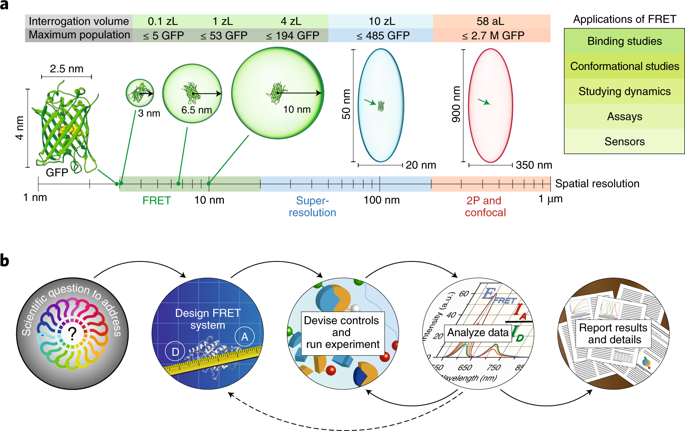Nature Methods ( IF 36.1 ) Pub Date : 2019-08-30 , DOI: 10.1038/s41592-019-0530-8 W. Russ Algar , Niko Hildebrandt , Steven S. Vogel , Igor L. Medintz

|
The applications of Förster resonance energy transfer (FRET) grow with each year. However, different FRET techniques are not applied consistently, nor are results uniformly presented, which makes implementing and reproducing FRET experiments challenging. We discuss important considerations for designing and evaluating ensemble FRET experiments. Alongside a primer on FRET basics, we provide guidelines for making experimental design choices such as the donor-acceptor pair, instrumentation and labeling chemistries; selecting control experiments to unambiguously demonstrate FRET and validate that the experiments provide meaningful data about the biomolecular process in question; analyzing raw data and assessing the results; and reporting data and experimental details in a manner that easily allows for reproducibility. Some considerations are also given for FRET assays and FRET imaging, especially with fluorescent proteins. Our goal is to motivate and empower all biologists to consider FRET for the powerful research tool it can be.
中文翻译:

FRET作为生物分子研究工具-在避免陷阱的同时了解其潜力
傅斯特共振能量转移(FRET)的应用每年都在增长。但是,不同的FRET技术不能始终如一地应用,结果也不能统一呈现,这使得实施和再现FRET实验具有挑战性。我们讨论了设计和评估整体FRET实验的重要注意事项。除了提供有关FRET基础知识的入门知识外,我们还提供了进行实验设计选择的指南,例如供体-受体对,仪器和标记化学;选择对照实验以明确证明FRET并验证实验是否提供了有关所述生物分子过程的有意义的数据;分析原始数据并评估结果;并以易于实现可重复性的方式报告数据和实验细节。对于FRET分析和FRET成像,尤其是荧光蛋白,也有一些考虑。我们的目标是激励和授权所有生物学家考虑FRET,因为它可能是强大的研究工具。































 京公网安备 11010802027423号
京公网安备 11010802027423号